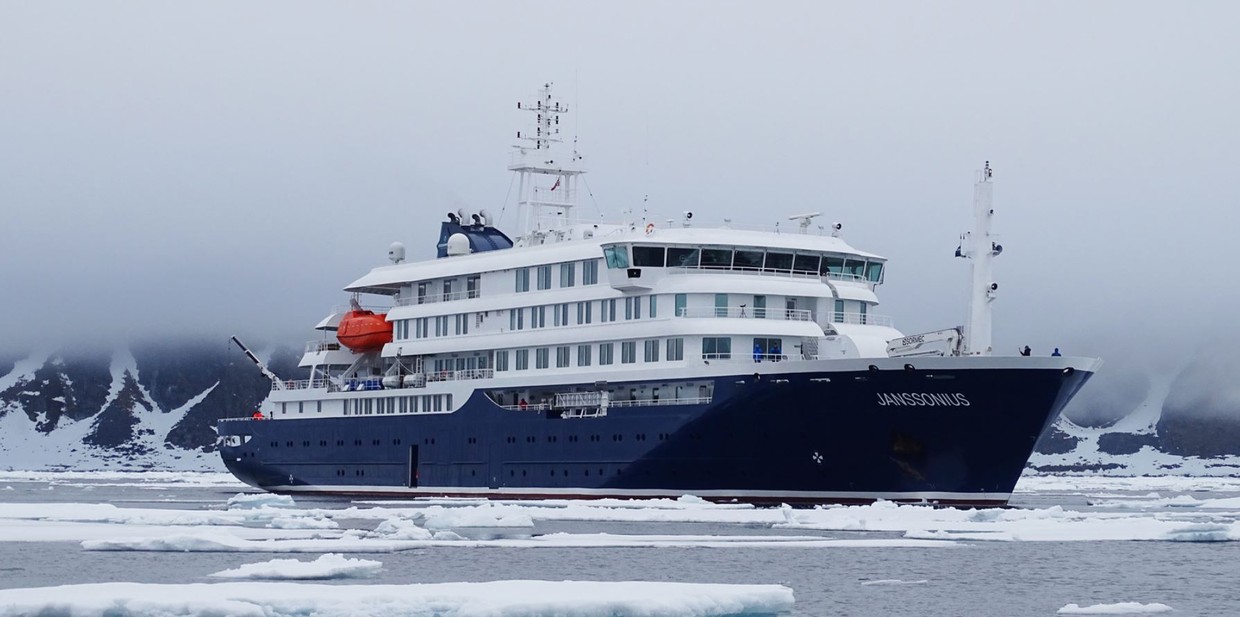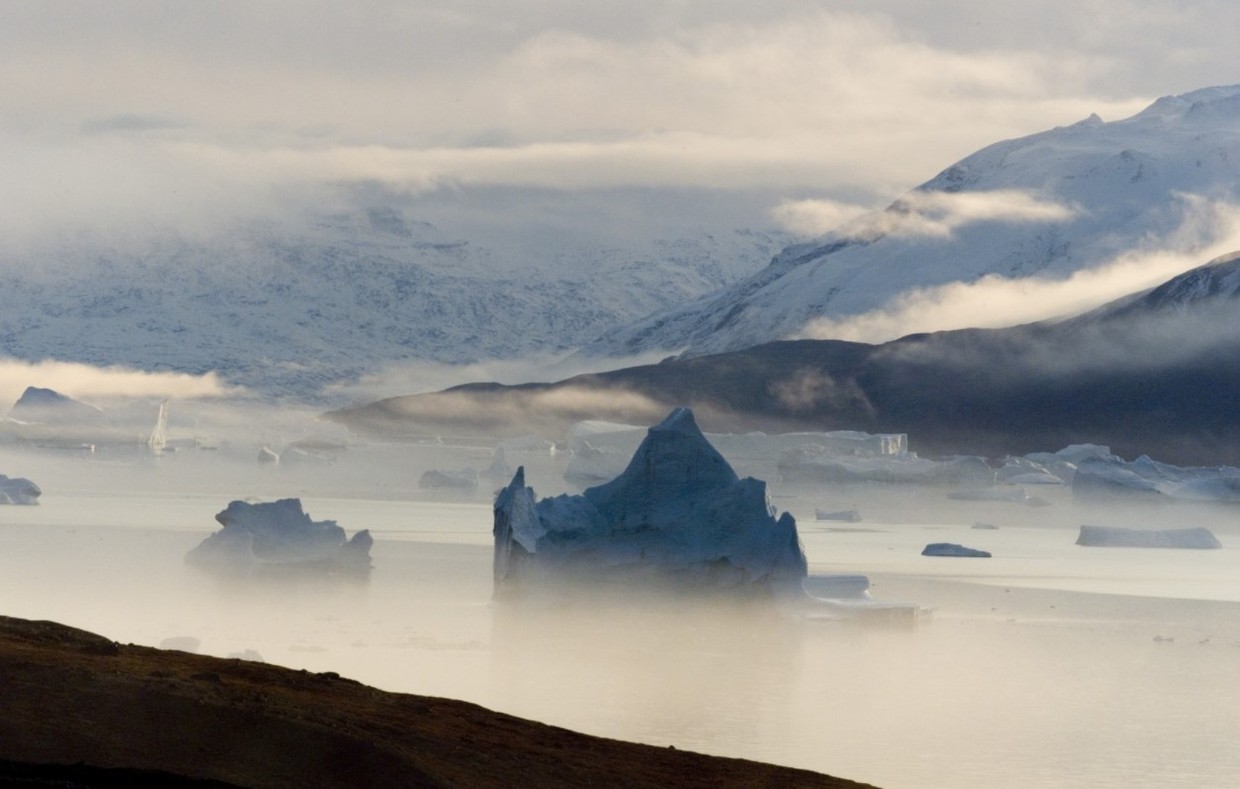from$ 11014 AUD
Note: Current p/p indicative rate. Final price may change due to currency fluctuations.
Janssonius
Longyearbyen to Akureyri
Overview
The Spitsbergen and Northeast Greenland cruise sails waters filled with breath-taking scenery. The expedition passes through areas that are home to seals, seabirds, whales, and polar bears, topped off with nighttime viewing of the Northern Lights.
Departures
Cruise Itinerary
You touch down in Longyearbyen, the administrative center of Spitsbergen, the largest island of the Svalbard archipelago. Enjoy strolling around this former mining town, whose parish church and Svalbard Museum make for fascinating attractions. Though the countryside appears stark, more than a hundred species of plant have been recorded in it. In the early evening the ship sails out of Isfjorden, where you might spot the first minke whale of your voyage.
Sailing to Raudfjorden, on the north coast of Spitsbergen, you take in an expansive fjord spilling with glaciers – and maybe even visited by ringed and bearded seals. The cliffs and shoreline of this fjord also support thriving seabird colonies, rich vegetation, and the possibility of polar bears.
When sailing westward along the 80 Degrees Parallel we soon see the jagged edge of the east Greenland sea ice flashing into sight ahead, depending on the conditions. Keep watch for whales and migrating seabirds here.
We work our way through the sea ice toward the Northeast Greenand Polynya and hope to reach Franske Øer and Ile de France. These Islands were first reached by Duke of Orleans on the Belgica in 1905. We want to go ashore at Kap St. Jacques, where under guidance of an archeologist of the Nuuk National Greenland Museum we can see the remains of Independence II culture.
When sailing into Dove Bugt, we have landing possibilities at the south coast of Germania Land, a mostly unglaciated area west of the Danmarkshavn station. Alternatively, we land at Store Koldewey, named by the second German Polar Expedition of Koldewey 1869 –’70.
At Shannon Island we try to land on Kap Sussi in the area of a German weather station from 1944. On Shannon Island Sabine in 1823 did his pendulum experiments. At its south side is Hvalros Island, where the population of walruses is increasing again.
At the south side of Clavering Ø the English Explorer Clavering met in 1823 local Inuit. It was the first and last time that these people ever were met by Europeans in Northeast Greenland, but the remains of their material culture are frequently seen. We hope to make a landing near Eskimonaes
As you approach Greenland, you may sail through the sea ice into Foster Bay and land at Margrethedal, where at the east side of the river are remains of Thule culture from some centuries ago. The lower tundra areas near the shores are populated by musk oxen. From here you sail through Kaiser Franz Josef Fjord, surrounded by towering mountains and bright interior icebergs.
You pass Teufelschloss (Devil’s Castle), a mountain with layered geology. On the other side of the fjord is Blomsterbugt (Flower Bay) and the intended landing site. In the afternoon we continue through Antarctic Sound and make a landing on Marie Island.
The first half of the day you spend in Blomsterdal (Flower Valley) near Antarctic Havn, a where we often spot groups of musk oxen. Another possibility is Ørsted Dal, with landing at Cape Seaforth. In the evening we sail through the strait between the island of Isikaja and the mainland. Until 20 years ago Isikaja was connected to the mainland by a glacier, which now has disappeared.
We sail southward in the cold East Greenland Current and later in the warm Gulfstream Current with a multitude of sea life (whales, seals, seabirds) at the mixing zones of these waters.
Every adventure, no matter how grand, must eventually come to an end. You disembark in Akureyri, where on request you can transfer (T) by chartered bus (a six-hour drive that you must book in advance) to the Reykjavik city hall, taking home memories that will accompany you wherever your next adventure lies.
All itineraries are for guidance only. Programs may vary depending on ice, weather, and wildlife conditions. Landings are subject to site availabilities, permissions, and environmental concerns per AECO regulations. Official sailing plans and landing slots are scheduled with AECO prior to the start of the season, but the expedition leader determines the final plan. Flexibility is paramount for expedition cruises. The average cruising speed of our vessel is 10.5 knots.
Janssonius

Vessel Type: Polar Class 6 Cruise Ship Length: 107.6 metres Passenger Capacity: 170 in 80 cabins Built: 2019/2020 Happier polar passengers, healthier polar environment Not only will the numerous amenities and on-board entertainments help make your Janssonius voyage truly memorable, this ship also gives you the peace of mind that comes with choosing one of the most environmentally friendly vessel on the polar seas. Janssonius uses LED lighting, steam heating, bio-degradable paints and lubricants, and state-of-the-art power management systems that keep fuel consumption and CO2 levels minimal. This means that when you sail aboard Janssonius, you get to enjoy the exotic landscapes and wildlife as much as possible while impacting them as little as possible. Hotel comfort, expedition class Janssonius offers high-quality accommodation for 170 passengers in six grand suites with balconies (27 square meters, 291 square feet), eight junior suites (19 to 20 square meters, 205 to 215 square feet), eight superior cabins (20 to 21 square meters, 215 to 226 square feet), 11 twin deluxe cabins, (19 to 21 square meters, 205 to 226 square feet), 14 twin window cabins (12 to 14 square meters, 129 to 151 square feet) as well as 27 twin porthole cabins, two triple porthole cabins, and four quadruple porthole cabins that vary in size from 12 to 18 square meters, or 129 to 194 square feet. The passenger capacity certificate for Janssonius is 196 persons. One deck consists of a large observation lounge and separate lecture room, which are reserved for a wide variety of interactive workshops, exhibitions, and performances particular to Janssonius. Though elegantly designed in stylish mid-century modern décor, this vessel holds true to Oceanwide’s distinctive cozy and informal atmosphere. Swift & safe ship-to-shore operations It is our philosophy to keep sea time short so that we can focus instead on fast, effective access to shore and near-shore activities. To give you the maximum contact with the nature and wildlife you traveled so far to see, we employ a tough fleet of rigid-hull inflatable Zodiac boats that guarantee swift and safe landing operations for the passengers. Janssonius has two separate gangways and a sheltered indoor Zodiac embarkation platform that can also be used for special outdoor activities, such as kayaking. The fast, flexible, friendly heart of the polar regions Our top priority is taking advantage of every wildlife and terrain opportunity as it occurs. To keep our itineraries flexible itineraries and our response time rapid, Janssonius is equipped with advanced stabilizers and two main engines capable of powering the vessel up to 15 knots. But Janssonius sacrifices no warmth to achieve its keen polar edge: You will have 72 crew and staff members (including expedition and hotel staff) at your service while on board, ensuring that what little time you do spend on the ship you will spend comfortably entertained.
Highlights
• Zodiac Cruising & Shore Program • Northern Lights • Kaiser Franz Joseph Fjord • Blomsterbugt • Arctic Hare • Minke Whale • Musk Ox • Ptarmigan
Map



